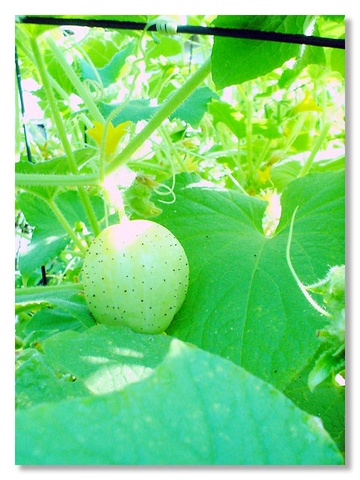Cucumbers [Cucumis sativus] are a tender, warm-season vegetable that produces well in Davis summers. They are one of the most ancient cultivated vegetables and are believed to have come from South Asia. There is some truth to the phrase, "cool as a cucumber," because the interior temperature of a cuke can be up to twenty degrees cooler than the ambient temperature. Aristotle spoke of the cucumber pickle's healing powers and Emperor Tiberius was such a fanatic that he ate cukes daily, developed methods to grow them year 'round and grew cucumbers in carts so his workers could wheel them around to chase the sun for a longer growing season. Even Julius Caesar and Napoleon believed pickles improved health and fed them to their armies. And finally, America was named for the Seville pickle merchant, Amerigo Vespucci, who would outfit ships for long ocean voyage; Amerigo was sure to pack vitamin-C laden vegetables such as cucumbers to prevent scurvy. As a beauty treatment for puffy eyes, the acids in cucumbers sooth skin irritations and reduce swelling.
Cukes grown in the backyard garden are typically of two types, pickling and slicing, and there are many varieties. Like so many of our favorite summer garden pickin's, cucumbers need lots of room for growth and can easily take up 16 square feet of garden space. The vines, however, can easily be trained upward, over wire tunnels or simply left to spread throughout your garden and into the yard.
Cucumbers can be seeded directly into the summer garden or planted as starts. Should you opt for direct seeding, be especially vigilant for the nightly march of the snails into your freshly prepared garden. Those with particularly large slug and snail populations may wish to apply snail bait near young seedlings. As with other summer vegetables, cucumber plants sulk if the soil is too cold; wait to plant until night time temperatures have warmed to about 55 degrees Fahrenheit.
Cucumber plants are shallow rooted and require consistently moist soil to produce well. For a mixed garden with a variety of watering needs, a drip irrigation system with multiple circuits can be set up simply and fairly inexpensively — this allows you to water your tomatoes less frequently but deeply while keeping the soil around the cukes more moist. Cucumbers also appreciate some additional nitrogen once they begin to vine... try turning some manure or organic fertilizer in at the time of planting so it will be available to the plants as their roots grow. Any stress to a cucumber plant including high temperature, low moisture, low fertility or foliage disease is said to result in bitter fruit.
Aside from the dangers of slugs and snails, some common problems attacking cucumbers include cucumber beetles, aphids, downy mildew, belly rot, leaf spot, gummy stem blight, pythium, bacterial wilt and a doubtless host of other creatively-named diseases. But cucumbers really aren't difficult to grow in our climate, so don't let this list put you off!
Cucumbers should be harvested earlier than later. If in doubt, pick it today, because by tomorrow it might have giant, inedible seeds throughout the middle. In fact, cucumbers can be harvested and eaten any time before the seeds become hard and are usually eaten when immature. Once cucumbers have turned yellow, you should cut them from the vine to allow younger edible fruits to develop.
UC Davis has a bunch of great information on storing cucumbers, which made it to Lifehacker in 2012. In short: store them at room temperature, not in the fridge.
To learn more about how our gardens grow in Davis, visit our Culinary Plants page.




